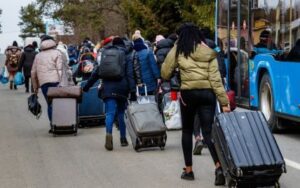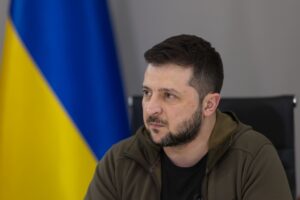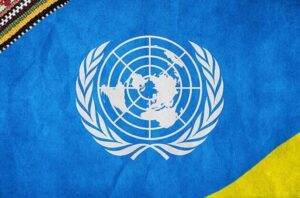
20% of the adult population of all Ukraine had to change their place of residence, while more of those who are forced to leave are in the eastern regions of the country (58%) and among young people (33%), according to the results of the nationwide survey “Socio-economic problems during the war”, conducted by the sociological group “Rating” on April 26.
The results of the study note that the rate of 20% of those who left their homes has remained unchanged since mid-March.
Since the beginning of April, the number of those who plan to return home in the near future has slightly decreased (from 29% to 22%). But there were more of those who would like to return, but a little later (from 24% to 31%). The number of those who intend to return home has hardly changed, but after the war (43%).
33% of respondents noted that they attended church on Easter, 67% did not attend. This is a higher figure than during the first quarantine (April 2020), but lower than it was before 2020. Most of those who were in church on Easter were among the inhabitants of the western regions and the rural population.
In the course of the study, 1,000 respondents over 18 years of age and older were interviewed using the CATI method (Computer Assisted Telephone Interviews – telephone interviews using a computer) in all areas, except for the temporarily occupied territories. The sample is representative in terms of age, gender and type of settlement, the error of the representativeness of the study with a confidence probability of 0.95 is no more than 3.1%.

The total amount of direct documented damage to Ukraine’s infrastructure as a result of the Russian military invasion has reached almost $88 billion, Head of the President’s Office Andriy Yermak said in a telegram.
“Over the past week, direct losses to the Ukrainian economy due to destruction and damage to civilian and military infrastructure have increased by $3.1 billion,” he wrote, referring to the “Russia will pay” project implemented by the KSE Institute with the support of the Office of the President of Ukraine, the Ministry of Economy, the Ministry of Reintegration and the Ministry of Infrastructure.
Yermak noted that the total losses of the Ukrainian economy – direct and indirect – due to the war range from $564 billion to $600 billion.
“Russia must be responsible for all crimes and destruction in our state, and it is at the expense of the aggressor, in addition to international assistance and money from our budget, that Ukraine must be restored,” the head of the Office of the President of Ukraine stressed.
He clarified that this estimate of the cost of losses from the ongoing war has so far been made only on the basis of public sources.
According to the data he cited, as of today, at least 23 thousand km of roads, 277 bridges and bridge crossings, 11 military airfields, 1 airport have been destroyed or seized.
In addition, 535 kindergartens, 866 institutions of secondary, higher and higher education, 231 medical institutions, 173 factories and enterprises, at least 75 administrative buildings were damaged or destroyed.

The American company Mondelēz International, one of the world’s largest producers of snacks and confectionery, has estimated its losses and additional expenses in the first quarter of 2022 due to the war unleashed by Russia against Ukraine at $143 million (after taxes – $145 million).
“In February 2022, Russia launched a military invasion of Ukraine, and the company closed its operations and facilities in Ukraine. In March 2022, the company’s two Ukrainian production facilities in Trostianets and Vyshgorod were seriously affected,” the company said in a quarterly report on Tuesday evening.
According to him, this amount included $75 million reflected in the impairment of these and other assets and exit costs, $44 million in cost of sales and $24 million in marketing, general and administrative expenses.
As reported, PrJSC Mondelis Ukraine (formerly Kraft Foods Ukraine) is part of the Mondelēz International (USA) group of companies, the holding company of which is Mondelēz Nederland Services B.V (Netherlands).
The company in Ukraine includes the Trostyanets confectionery factory (Sumy region) and a subsidiary company “Chipsy Lux” LLC (Kyiv region).
Since 2003, Mondelis Ukraine has been managing business development in the Moldovan market, since 2005 – in the markets of Belarus, Georgia, Armenia and Azerbaijan, and since 2008 – also in the markets of Kazakhstan, Uzbekistan, Kyrgyzstan, Tajikistan, Turkmenistan and Mongolia.
The company’s business in Ukraine as of autumn last year amounted to more than $400 million. Mondelis Ukraine invested more than $200 million in business development in Ukraine.
“Mondelis Ukraine” sells products under the trademarks “Korona”, Milka, “Vedmedic “Barni”, Tuc, “Belvita! Good Morning!”, “Lux”, Halls, Dirol, Picnic and others.

President of Ukraine Volodymyr Zelensky said he wants the end of the war with Russia and spoke in favor of a diplomatic way to end it.
“I want to stop the war and end it. There is a diplomatic path, there is a military one. Any healthy person always chooses the diplomatic path, because he knows: even if it is difficult, it can stop the loss of thousands, tens of thousands, and with such neighbors hundreds of thousands, and maybe even millions of victims. I don’t want this. And any leader, whether he personally wants it or not, has no right to subjectively cancel the diplomatic path,” Zelensky said at a press conference in Kyiv on Saturday.

Since the beginning of Russia’s armed invasion of Ukraine, 93 enterprises have moved to Lviv region, the press service of the Lviv regional military administration reports.
“In general, we have processed more than 400 applications for relocation. Of the 93 enterprises that have already moved, 38 have started work,” Orest Filts, the head of the investment policy department at the administration, said.
According to him, representatives of food, chemical, furniture, light industry and woodworking moved to Lviv region. As Filts noted, among them is Gemini Espresso, a natural coffee company, and MatrolLux, a manufacturer of mattresses, upholstered and cabinet furniture.
According to him, two more machine-building enterprises are planning to start work soon – Wind Farms of Ukraine LLC, which is part of Kramatorsk Heavy Machine Tool Plant, and Pozhmashina, the only manufacturer of specialized firefighting equipment in Ukraine.
According to the estimates of the Lviv regional administration, more than 2,500 jobs will be created at the displaced enterprises.

Civilian casualties from February 24, when Russia started the war against Ukraine, to 24:00 on April 19 amounted to 5,121 civilians (4,966 in the report a day earlier), including 2,224 dead (2,104), reports the Office of the High Commissioner UN Human Rights on Tuesday.
The daily summary traditionally states that the increase in figures from the previous summary should not be attributed only to the cases that occurred on April 19, since during the day OHCHR also verified a number of cases that occurred in previous days, however, the increase in the number of deaths is the second largest the largest during the entire war.
“OHCHR believes that the actual figures are much higher as information is delayed from some areas of heavy fighting and many reports are still awaiting confirmation,” the UN data document notes.
According to him, this applies, for example, to Mariupol (Donetsk region), Izyum (Kharkiv region), Popasna (Luhansk region) and Borodianka (Kyiv region), where there are reports of numerous civilian casualties. They are subject to further verification and are not included in the above statistics.
“The majority of civilian deaths or injuries were caused by the use of explosive devices with a wide area of effect, including shelling from heavy artillery and multiple launch rocket systems, as well as rocket and air strikes,” the report says.
According to confirmed UN data, 631 men, 383 women, 61 boys and 42 girls died, while the sex of 70 children and 1037 adults has not yet been determined.
Among the 2,897 injured were 59 girls and 64 boys, as well as 157 children whose gender has not yet been determined.
Compared to the previous day, according to the UN, three children were killed and three more were injured.
OHCHR indicates that in Donetsk and Luhansk regions, as of midnight on April 20, there were 746 (660) dead and 1,078 (1,070) injured in government-controlled territory, and 79 (79) dead and 325 (320) injured in territory controlled by self-proclaimed “republics”.
In other regions of Ukraine under government control (in Kyiv, as well as in Zhytomyr, Zaporozhye, Kiev, Sumy, Odessa, Mykolaiv, Kharkiv, Kherson, Dnepropetrovsk, Cherkasy and Chernihiv regions), the UN recorded 1399 (1365) dead and 1494 (1472) wounded .
The report also states that, according to the Office of the Prosecutor General of Ukraine, as of 8:00 am on April 20, 205 (205) children were killed, 373 (367) were injured.